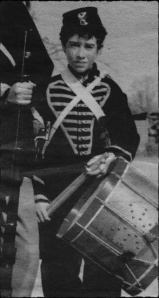
When I was a kid, I knew a family who were Civil War Reenactors. Their son was around my age and played the bugle. What their reenacting unit lacked was a drummer. At age 12 I “joined up” and began learning the basic drum calls and cadences. The most important and by far the easiest was the marching cadence. This was a simplistic ruff and flam cadence meant to provide a beat for the soldiers to march to.
“Sir, they are beating the long roll.”
“What is the long roll for?”
“The long roll man, the long roll! Get your gun; they’re beating the long roll!”
-Sam Watkins, Company Aytch
Another common call was “Assembly,” which was meant to gather the troops into immediate formation. Yet again, the call was simple and easy to learn, consisting of rolls and flams in the same order as the marching cadence. Finally, I learned the most popular tune of the war, Army 2/4 or “Biddy Oats.” This was written to accompany the fife, as each military unit was supplemented by a fife and drum corps. These songs were meant to cheer the soldiers up and on, in times of peace and times of war. While I cannot play the fife, I have recorded these three drum calls in all their glory below.
.
What Else Did Drummers Do?
Coincidentally, at the first reenactment I ever participated in, another drummer my age showed up to join. Having only one drum, this meant that we took up different duties whenever the other was playing. The only major battle that took place on Ohio soil occurred on the Ohio River near the West Virginia border. This battle, the Battle of Buffington Island, was very important to Ohio reenactors as it was our only claim to fame: being our only battle site and a Union victory as well.
I participated in the reenactment of Buffington Island around its 140 year anniversary, making it an especially grand event. Fate however had something else in mind, and 13 year old me was crushed to find out that it was not my turn to play the drum that weekend. This meant that I could be acting as a messenger, flag-bearer, ambulance corps assistant, etc. As many drummers before me had, I served as a messenger during the battle, relaying orders from one general to the next.
Who Were These Drummers?
Much like my experience, many drummers of the Civil War were between the ages of 10 and 15. Defying the odds, the most famous drummer of the war was a 9 year old from Central Ohio named Johnny Clem. No Ohio regiment would accept him as they deemed him too young, so he ended up following a Michigan regiment until he was officially allowed to enlist in 1863. Later that year at the battle of Chickamauga in Georgia, Clem gained notoriety for being surrounded by Confederates, shooting one of their Colonels, and then escaping; earning him the nickname “Drummer Boy of Chickamauga.” Clem went on to be promoted to Sergeant and had a lengthy career in the United States Armed Forces.

Gear & Specs
For those of you who have ever held a drumstick, you know that weight, length, and even wood type can make the slightest difference. In the mid-1800s, there were little options to choose from. I opted for the most common, the Cooperman Civil War #50. While these are the average length of the modern drumstick, they are nearly an inch wide at the base. Playing in the traditional style, this certainly took some getting used to. You can still purchase these drumsticks, and I challenge any modern drummer to try them out.

What Have We Learned?
If you made it this far, you’ve probably learned that drummers of the Civil War were usually children far from home and often in harm’s way. From acting as a messenger to shooting enemy forces at close range, being a drummer was never more difficult. It’s easy to take for granted the little issues modern drummers face, but when I think about kids like Johnny Clem, I realize I’ve never had it so easy.
Support: